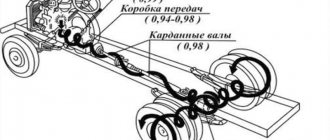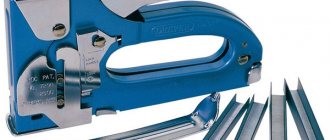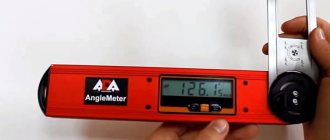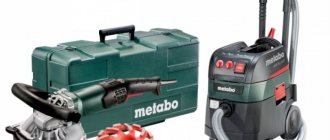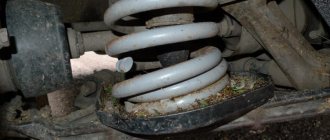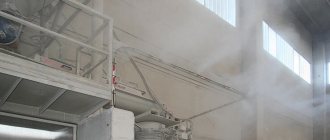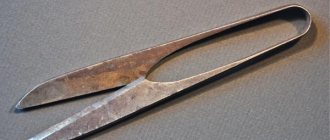One of these devices is a plumb line with a cord.
What is it for and how to use it? This is a special device with which you can accurately determine and check a vertical plane or line.
[contents]
This is a simple device that consists of a weight located at the end of a cord. Therefore, its other name is a cord plumb line; people also call it a cord and a cord. Often it comes with a device that makes it more convenient to mount it on the wall. Using this simple tool, the verticality of structures, walls and buildings is determined.
Using the device, you can draw a line on the wall strictly horizontal to the floor. The cost of the device is low and ranges between several hundred rubles. A fairly wide range of prices is explained by the design of the device, which can be elementarily simple, or may have additional devices.
- 1 Simple plumb line: device
- 2 Construction plumb line with cord - how to use? 2.1 Construction magnetic plumb bob
- 2.2 Laser plumb line 2.2.1 Electronic plumb line
- 2.2.2 Is it possible to make a construction plumb level yourself?
Laser modifications
The vertical position of the surface under study can be checked with laser plummets. The simplest representative of this category is the pointer. It is made like a keychain with a laser target pointer. There are not so many similar devices focused exclusively on construction work. One of the modifications is a metal body, on the pin of which the pointer is located.
The device generates points on the floor and ceiling. The leveling process occurs automatically using a special mechanism that vaguely resembles an analogue of a cord plumb line. Well-known manufacturers in the construction market offer devices with an operating range of up to 30 meters. They are highly accurate, powered by batteries, and quite expensive.
Inexpensive products from little-known companies and homemade versions are widely offered in the markets. Such an instrument requires control testing using reliable reference instruments. One of the design options is a plastic case with an LED placed inside and a self-leveling system that responds to a certain degree of deviation in the horizontal plane.
Principle of operation
A plumb line with a cord consists of the following parts. These include:
- head;
- frame;
- long rope or thick thread;
- plank
Read also: How should a men's shirt fit?
The operating principle of this device is quite simple. Metal weighting provides the necessary gravity. The weight and brand of the model are indicated on the surface of the case. During the working process, the rope is tensioned under the influence of a heavy base. Thanks to this, a vertical line is formed on the plane.
To achieve special accuracy in the process of determining the guides, it is recommended to round the end of the iron part. To do this, use a file or highly abrasive sandpaper.
Construction plumb line with cord
A plumb line with a cord is a small metal weight on a long rope. This device comes with an additional fastener for tight fixation on a hard surface. This tool is designed to determine the vertical plane of walls and any buildings.
Thanks to this device, it is possible to make an even vertical or horizontal line in relation to the ceiling. It is often used in the initial stages of construction of a residential building. It ensures even laying of the building material.
The product has a low cost, which makes it accessible to every consumer. You can make such a device yourself using available materials.
How to make a plumb line with your own hands
If installation work is in full swing and you urgently need to set or check verticality, there is no need to waste extra time and run headlong to the store.
A simple plumb line can be done quickly and without much effort yourself.
Initially, you should decide on the desired size of the product.
If you need to level a surface that is not large in size, then you need to find a strong meter-long cord.
A regular nut or an empty perfume bottle is quite suitable as a weight.
When work is carried out in open conditions and it is necessary to set the verticals, for example when erecting a brick wall, then a larger plumb line is needed.
Therefore, it is better to take a filled plastic bottle for the load, and a strong clothesline for hanging.
In any case, you should tie the rope to the selected sinker, after which you can use the manufactured structure for its intended purpose.
Please note that when working with a homemade tool, you need to make a small indent from the surface being measured (at least 2 - 3 cm) in order to get accurate readings.
Plumb line length
The standard version provides a length of 5 meters. But for interior spaces, a height of 2.5-3 meters is quite sufficient. This is quite enough to decorate any living space.
Algorithm for working with marking cord
The design of the device is quite simple, using the marking cord is also easy.
How to refill
In order for the cord to leave a clear and contrasting mark on the marked surface, the body must be filled with high-quality coloring powder. During the unwinding process, the thread is coated with powder and becomes ready for marking.
In order to fill the body with dye, you need to unscrew the cap covering the loading hole. Powder is poured into it.
Its supply inside the case will have to be replenished whenever the marking line, broken off by the cord, begins to fade.
When using for the first time after purchase, you must completely unwind the thread and fill in the pigment to three-quarters of the volume of the body. Next, the thread is wound up and the device is shaken vigorously. You should not save on purchasing a coloring composition. In Moscow, powder of acceptable quality should not cost less than 80-100 rubles
How to thread the marking cord
Performing markup
First, using a hydraulic or laser level, reference points are placed at the beginning and end of the marked line. Screws are screwed into them or small nails are driven into them. The marking thread is stretched between them. Now you need to take the cord by the middle with two fingers, pull it a little in a direction perpendicular to the surface and the marked line and release it. A clear straight line should appear on the surface. Now you can remove the cord from the markers and move on to marking the next line.
If it is possible to attract an assistant, the work will speed up significantly. No need to attach markers. One presses the beginning of the thread, the other the end. One of the workers pulls back and releases the thread.
Marking with marker cord
How to use a marking cord correctly in specific situations?
To mark gypsum suspended ceilings, you must follow the following recommendations:
- Find the lowest point on the rough ceiling, which will be covered with plasterboard. To do this, use a hydraulic level or level. It will be much more convenient and faster to use a laser level. Its high price will pay for itself many times over due to the time saved.
- At the found level, a mark is made on the nearest wall. Using a level, spirit level or laser level, I repeat the mark twice on each wall.
- The beginning and end of the marking cord are recorded using the marks set; it should fit snugly to the surface.
- Take the thread by the middle with two fingers, pull it a little and quickly release it. After impact, the paint powder leaves a smooth mark on the wall.
- The operation is repeated on the remaining walls.
The broken contour will serve as a guide for installing the starting guide profile, to which the suspended ceiling will be attached.
If the room has an imperfect shape, deviating from a regular rectangle, then when laying ceramic tiles on the floor, even rows will emphasize this. In one corner the wedge will be clearly visible. To disguise such a defect, the tiles are laid diagonally.
Marking with marker cord
To apply diagonal markings to the screed under a ceramic tile floor, proceed as follows:
- The marking cord is pulled between the corners of the room at a height of 5-10 mm from the surface of the subfloor and the main diagonal is marked.
- The cord is stretched between the other two corners and the second diagonal is beaten off.
- The intersection point of the two lines will mark the geometric center of the room;
- From it, on both sides along the main diagonal, the first two rows of tiles should be laid out, using centering crosses to maintain equal distance and spacing.
Next, the rows of tiles are laid from the center to the auxiliary corners, using the first two rows as reference ones.
How to make a plumb line yourself?
If planned or urgent construction work is planned at home or on a personal plot, and there is no plumb line in the tool kit, there is no need to rush headlong to a specialized store. When you need to determine a straight vertical line or level a surface, a homemade analogue is quite suitable.
To make a plumb line, you will need a reliable, strong cord (its length is approximately 1000 mm). Any suitable object is taken as a load, for example, a heavy nut. After checking the reliability of fixation of the two elements, you can begin work. When taking measurements, you should hold the thread firmly and make sure that the load does not untwist to the sides. If you need to check a small surface, you can use a small cosmetic bottle instead of a nut.
The main thing when working with such a tool is not to let the device come into contact with the object being measured. There should be at least a minimum gap between them.
To carry out large-scale manipulations, you will need an appropriate tool. Instead of a thin cord, it is better to take a thick twine, and a plastic container with water can completely replace the load. Although experts still recommend using metal weighting materials.
Criteria for choosing a plumb line
When choosing a plumb line, pay attention to:
- Type of construction work required;
- Material of manufacture;
- Thread length:
- Required measurement accuracy;
- Additional features.
The cost of the device may vary from manufacturer to manufacturer. But to a greater extent the price depends on the number of additional services, which are not always used. So for small DIY repairs, it’s quite possible to buy the simplest model.
What you need to know about plumb lines
Using any type of plumb line, you can quickly identify any inconsistencies during the construction or installation of vertical surfaces/objects.
This tool is always used when:
- handicraft furniture production;
- installation of window and door systems;
- construction of formwork/foundation;
- construction of brick buildings, log houses;
- laying tiles;
- alignment of the picture, etc.
That is why many builders always prefer to check the readings of the device and often install it in a permanent place so that during the process of reproducing work they can quickly use it for its intended purpose.
Plumb weight
Depending on the purpose of using the plumb line, weights of different weights are used:
- for indoor work, a mass of 100 grams is sufficient;
- on the street you will need a slightly larger load, within 300 grams;
- in strong gusts of wind, even heavier heads are used.
However, tools with such weights are more expensive and less convenient to carry and use. And there will be more damage when such massive weights fall.
Where is it used?
A plumb line is an indispensable thing during construction. The scope of application of the device is very wide. It is needed for the following construction processes:
- control of surface evenness;
- installation of a plaster beacon;
- drawing vertical lines;
- installation of door and window openings;
- installation of roof rafters;
- placement of formwork.
If there is a need to adjust vertical surfaces, then it is necessary to use a plumb line. It should be noted that excavation work is accompanied by the use of a plumb line. This device helps determine the evenness of the walls of trenches and pits. Masons also use a plumb line when performing their work.
If you are engaged in repairs and plan to hang wallpaper, it is the cord plumb line that will ensure even and high-quality gluing of the material.
The modern market is overflowing with various types of construction plumbs. You can choose exactly the one that is suitable for a certain type of work. Such instruments are divided into the following types.
- Classic. The constituent elements of this type of plumb line are a metal boning and a cord. A representative of this class is a magnetic plumb line. It is characterized by the presence of a built-in magnet. This feature makes it possible to attach the device to a metal surface. The device can also be used when working with wooden surfaces - there is a special needle that is used as a fastening element.
- Laser. This plumb line is often used in the construction process. The device is characterized by its small dimensions and the ability to operate on both battery and battery power. When turned on, the device directs laser beams to the desired surface. To determine the discrepancies, you just need to look at the screen where all the indicators are visible. Today this device is very popular. This is due to ease of use and functionality.
There are models of laser plumb line that record and display not only vertical indicators, but also horizontal ones and even angular deviations. Of course, they are more expensive than standard ones.
- Electronic. This is not the name of a device, but an application for a mobile phone. Its installation is possible if the phone is based on Android OS. This application is becoming more and more popular every day, because it is very convenient to use - it is always at hand. All you need to do is install the gadget on the surface under study. The application will independently determine all deviations and show them on the smartphone display.
Primitive plumb line: device
The meaning of his work is simply simple. The weight provides the proper gravity, and during operation the cord is tensioned, precisely determining the vertical direction. During the manufacturing process, established standards are applied. What equipment is included in the device?
It consists of a head, body, insert, rail and cord. Good steel is suitable for the body and head; polyamide can be used for the insert. Slats are made from sheets of aluminum grades AD-1 or AD, the thickness of which must be no more than 2 millimeters (other types of non-ferrous metal can also be used).
To enable more precise work, sharp edges must be softened. The cord used is chlorine or nylon fibers wound into a rope. You can replace them with other materials that have appropriate reliability and strength. This device is very easy to create with your own hands; to do this, you use suitable materials available at hand.
Types of plumb lines and their purpose
A construction plumb line is an indispensable tool when performing almost any type of installation work.
In addition to the usual cord plumb, products are divided into the following types:
Classic plumb
It consists of a metal blank and a cord; one of the varieties of such a plumb line is a magnetic plumb line.
The magnetic version is distinguished by the fact that it has a built-in magnet, thanks to which the tool can be attached to any metal surface.
Laser plumb line
This product has small dimensions; the design of the item may vary depending on the manufacturer.
The device can be powered by a removable battery or simple batteries.
When you turn on the device, the system independently projects laser dots onto the walls, floor and ceiling.
Determining level discrepancies is not difficult, since usually all indicators are displayed on a small plumb screen.
If it is absent, special lines are displayed on the measured surfaces; their distortion indicates the presence of inconsistencies.
This type of device is easy to use.
In addition, modern models combine several functions at the same time - optical systems measure verticals, horizontals and angular divergence.
An alternative to such a plumb line is a regular laser pointer.
Electronic plumb line
It is a special application that is installed on a smartphone based on the Android system.
It is very convenient to use such a program.
When the phone is placed on the surface under study, indicators of the deflection angles and their direction are displayed on the display.
Homemade plumb line
This product has the most simplified design.
It looks like an ordinary nut or any other object, to the end of which a strong thread/rope is tied.
Device and characteristics
The design of a conventional plumb line consists of a weight, which has the shape of a cylinder with a pointed end (visually the object resembles an oblong bullet) and a cord attached to the center of the base of the weight.
Using this device, you can quickly check the verticality of various surfaces or buildings, and, if necessary, mark vertical lines on a wall or other covering.
The price of plumb lines is more than acceptable.
You can buy such a product for an average of 100 rubles.
But it is worth considering that more modern models equipped with additional functions will differ significantly from the declared cost.
How to use
A plumb bob is a device for checking the verticality of surfaces. Therefore, it must be secured at the top point of the plane or object being tested.
Some models are sold with a washer of the same diameter as the cylinder. It turns out that there is a weight at one end and a washer at the other. By applying the washer to the surface and calming the vibrations of the load, you can see if there is a difference between the vertical of the thread and the plane being tested.
By the way, the shadow from the thread is also vertical. So you can navigate by it.
Applying the thread to a vertical surface, wait until its vibrations calm down, and then see if the distance from the surface being tested to the cord is the same
Other models do not have a washer, but are wound on a piece of plastic, sometimes with markings on it, like on a ruler. There are plumb lines whose cord is hidden in a plastic case (like a tape measure). Some people find them more convenient to work with, and the body can be used as a support for the cord.
During long-term work (plastering, for example), it is necessary to have a plumb line in front of your eyes and level the surface along it. Then the fastener is most often a long nail or self-tapping screw. It is hammered/screwed in so that it holds tightly, but a significant portion of it sticks out. A cord is tied or wound near the cap, and the weight itself is lowered to the required distance. After the vibrations have stopped, the thread with the weight is an ideal vertical. Having a standard in front of your eyes, you can compare how smooth the surface in front of you is.
In this way you can check the verticality of the wall, the correct placement of household appliances, furniture, etc.
How to “break off corners” using a plumb line is shown in the video. It's difficult to describe, it's better to see. In short, you need to “catch” whether the angle, the plane of the wall and the plumb line coincide or not.
When laying a brick wall, a plumb line with a cord is necessary so that you can check whether the wall has fallen off. To do this, apply it to one side of the wall and the other, checking the distance from the cord to the surface along its entire length. It is clear that the distance should be the same. Such control is carried out at several points. The verticality of walls made of timber and logs is controlled in exactly the same way. But when using non-rounded logs, control is more difficult due to the different diameters of the crowns. However, you can see the deviation in this case too. A plumb line is useful when setting up formwork, installing doors, and constructing a roof truss system. Yes, it is needed in almost any construction and many finishing operations.
The same can be done using a building level. It is much simpler and faster, but this device has a fairly large error. As a result, the walls will move—bend into a hump, or form holes. Therefore, a combination of the two dimensions is desirable. With a little experience, you can check walls with a plumb line through four or five rows of brickwork, using a level the rest of the time.
The cord level has one rather serious drawback: it is almost impossible to work with it in the wind: the weight constantly wobbles, which makes it impossible to fix the position of the cord. In order to somehow combat this scourge, they came up with the idea of immersing the load in a vessel with water. Place a vessel below and recess the plumb cone a little. You can work in moderate winds.
Magnetic plumb line
A magnetic plumb line is the same as a cord plumb line, only it is attached using a magnet.
What upsets builders and installers the most is that they need to fiddle around and somehow secure the cord. The second problem is that the thread often gets tangled, which also does not improve the mood. So they came up with an improved construction plumb line, the thread of which rolls onto a reel located in the body. And to make it more convenient to attach it, several magnets were built into the body. It can be easily installed on any metal surface: a magnet holds it at the desired height.
To make it easy to attach to wood, a needle is made in the same body. So this problem is solved. Due to the presence of magnets in the body, this plumb line received the name “magnetic”. A very convenient and practical thing.
The second version of a homemade plumb line
Magnet: to align vertically on a construction site
There are different types of such tools, the most popular ones are corded and magnetic plumb bob. Recently, such devices as specialized construction devices, electronic devices, painting devices, laser devices, and cone devices have also been encountered. Construction models can be considered simple and at the same time reliable measuring instruments. More often they are a metal cylinder with a steel cone at the end, and the whole thing is suspended on a strong cord.
The upper part of the metal cylinder has a threaded hole and a bolt is screwed into it. A cord is inserted into the hole itself through the bolt, but a knot is made on the side of the head for strength. The bolt is screwed into the base itself or into the body, and a rope is also threaded there. The most important thing in this design is that the top is located along the axis of the cylinder; this is calibrated at the manufacturer, although it would be a good idea to check this before use. Sometimes the device is made entirely in the form of a cone, then they say that the plumb line is conical, although its shape does not affect the operation.
Material
To produce a standard cord plumb line, the following elements are usually used:
- weight body - steel head with polyamide insert / galvanized steel;
- strips - made from aluminum sheets (grade AD or AD-1, no more than 2 mm thick);
- lace - a rope made of chlorin/nylon fibers.
These materials provide adequate structural strength, but if you make the tool yourself, you can replace them with improvised means that have similar characteristics.
